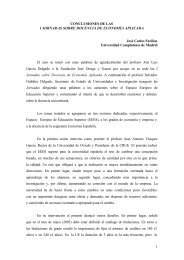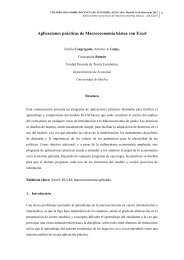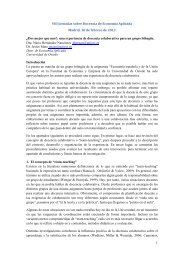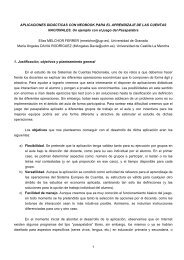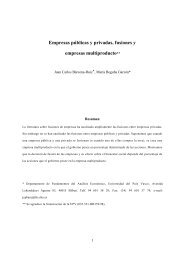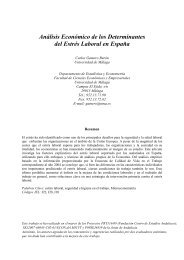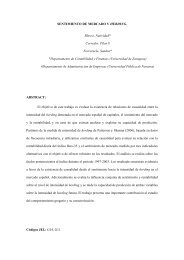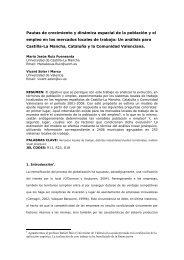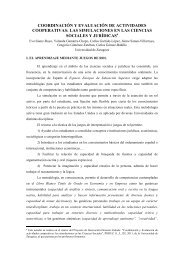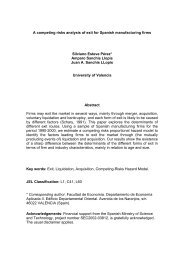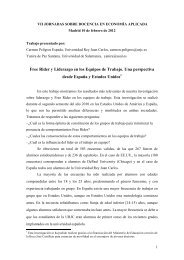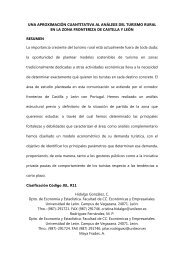Job Characteristics and Gender Wage Differences Revisited ... - ALdE
Job Characteristics and Gender Wage Differences Revisited ... - ALdE
Job Characteristics and Gender Wage Differences Revisited ... - ALdE
You also want an ePaper? Increase the reach of your titles
YUMPU automatically turns print PDFs into web optimized ePapers that Google loves.
<strong>Job</strong> <strong>Characteristics</strong> <strong>and</strong> <strong>Gender</strong> <strong>Wage</strong> <strong>Differences</strong> <strong>Revisited</strong>:Evidence from SpainJaume García VillarUniversitat Pompeu FabraCarmen Rubio CastañoUniversidad Pablo de OlavidePreliminary versionMarch 10, 2008
1 Introduction<strong>Gender</strong> wage gap in Spain remains substantial in line with the situation in othercountries. Data from the Spanish <strong>Wage</strong> Structure Surveys in 2002 estimates the difference inaverage wages between men <strong>and</strong> women around 20%. The data reach a great relevance as faras women’s participation in the labour market growths.In analysing this differences economists have usually followed a human capitalapproach where wages are explained basically by variables capturing individual characteristics,including very few variables related to the characteristics of the job the individuals hold, as aconsequence of the type of surveys they use. The most recent results obtained for the Spanishlabour market are found in the works of Garcia et al. (1998), Garcia et alia (2001), Aláez <strong>and</strong>Ulibarri (2001), Gardeazabal <strong>and</strong> Ugidos (2002), Hernández <strong>and</strong> Méndez (2005), De la Rica etalia (2005), Simón, H (2006), <strong>and</strong> García <strong>and</strong> Morales (2006) . In recent years the interest isfocused not only in the estimation of the gender wage gap but firstly to contrast the existence ofthe glass ceiling in Spain <strong>and</strong> secondly in the comparison of the gaps between regions in Spain<strong>and</strong> countries in European Union, due to the availability of data: the Survey of <strong>Wage</strong> Structurein Spain 2002, the European Community Household Panel, the European Survey of <strong>Wage</strong>Structure in 1995 <strong>and</strong> data from the Spanish Social Security.Even if the data sources <strong>and</strong> methodologies applied are different, all these studies findthat a substantial percentage of the wage gap is due to the returns to observable characteristicsin favour of men. They have in common also the scarce information in jobs characteristics.In this paper we use individual data from the Encuesta sobre discriminación salarial ycaracterísticas del puesto de trabajo, 2002 (Proyecto ISOS) in order to examine the influence ofboth job characteristics <strong>and</strong> individual characteristics on wages. There are more than onehundred questions in the survey which are related to the description of the job hold by theindividual. This allows us to define 17 factors (<strong>and</strong> the corresponding subfactors) which describe(quantify) the working conditions (3 factors), the knowledge <strong>and</strong> skills required (6 factors), theeffort (4 factors) <strong>and</strong> the responsibility (4 factors) associated to each job. Data have beencollected from a human resource management’s perspective in order to be able to perform2
some job evaluation exercises <strong>and</strong> the information is much more detailed than that used in theexisting literature on this topic.The aim of the present work is, using this information, to explore the effect of jobcharacteristics on wages <strong>and</strong> mainly to analyze to what extent the introduction of these jobcharacteristics helps to explain the male-female wage differential which is not explained by thedifferent characteristics males <strong>and</strong> females have. There are two steps involved, first, theprevious estimation of hedonic wage equations by gender which shows the relationship amongstock of human capital, working conditions <strong>and</strong> wages <strong>and</strong> secondly, the decomposition of thegender wage gap, in this case using the extended Oaxaca-Neumann decomposition <strong>and</strong>concretely their review in 1994.Our results indicate that the characteristics of both, individual <strong>and</strong> jobs determine pay.Moreover, the introduction of job characteristics reduces substantially the part of the genderwage gap usually attributable to discrimination. We also find that, females hold jobs that globallyare rated to be of equal value than males contrary to other studies (Schumann et alia, 2001,<strong>and</strong> Filer, 1990). This fact points to the effectiveness of the evaluation system in neutrally jobevaluation to gender.We describe the specification in section 2. In section 3 we briefly describe the survey<strong>and</strong> discuss the individual <strong>and</strong> the job characteristics data. Section 4 presents the empiricalresults on the effect of job characteristics on pay <strong>and</strong> the decomposition of the gender wagegap. We summarize our findings in section 5.2 The model: econometric specificationThe usual approach in analyzing gender wage discrimination is based on the humancapital theory <strong>and</strong> the idea that wages are related to productivity: without discrimination genderdifferences in productivity determine differences in salaries. The wage discrimination appearswhen workers with identical productivities receive different retribution.3
In this sense quantifying discrimination imply the assessment of difference in meanwages, known as gender wage gap, <strong>and</strong> also the division of this gap in two parts. First part theexplained part of the gap assembling the divergences in individual workers characteristics,those measuring productivity <strong>and</strong> usually called endowments. And second part, the“unexplained” fraction of gap or the difference in the rate of returns to these characteristics. Thislast part is usually attributable to discrimination.Another line of research trying to explain wages divergence by gender is thecompensating differential theory. According to this theory the diversity of preferences by genderin relation to work characteristics determines the wage differences. Moreover, women are paidless than men because jobs typically held by women are characterized by more favourableworking condition that jobs dominated by men. If correct, once job characteristic are fullyincorporate to the explanation of wages no evidences of discrimination remainsWe find less empirical evidence sustaining or refuting this theory than the human capitalone, especially in Europe, because no data on jobs characteristics are frequently available withthe exception of working conditions. Testing this theory involve the analysis of both, thedistribution of undesirable employment conditions by gender, <strong>and</strong> the existence of wagepremiums or positive rates of return for this unpleasant characteristics. In our concern the pointis whether the same job characteristics are rewarded differently.In line with the arguments previously presented, job characteristics, <strong>and</strong> not only thestock of human capital, are partly approximating the unobserved productivity. Consequentlyexplaining wages <strong>and</strong> the differences in compensation by gender, without the non-wagecharacteristics of job may overstate these differences <strong>and</strong> the estimation of fraction due todiscrimination.Focusing on the estimation of wage equation with the available data we will analyze firsta hedonic wage equation including work characteristics <strong>and</strong> lately decompose the gap. Theestimation of labour market discrimination by gender is based on the wage decompositionmethodology by Blinder (1973) <strong>and</strong> Oaxaca (1973). In this methodology, one uses theseparately estimated (log) wage equations (0) for two groups of workers to decompose the4
difference in their mean wages into a discrimination (unexplained) portion <strong>and</strong> a human capital(explained) portion. The original decomposition procedure adopts one of the estimated wagestructures, the male or the female, as the non-discriminatory norm. In this case the entirediscriminatory wage differential is ascribed to underpayment of women or overpayment ofmales, respectively.ln( Wln( Wmf) = X) = X'm'fβ + Z ϕ + umf'm'fmβ + Z ϕ + ufmf(0)Using male’s structure as the non discriminatory, <strong>and</strong> as usual without jobcharacteristics we will obtain the following expression (1). <strong>Differences</strong> in the meancharacteristics of the two groups weighted by the estimated coefficients in the male structure<strong>and</strong> added, leads to the human capital portion of the differences, B. By aggregating thedifferences in the estimated coefficients between the two groups weighted by the meancharacteristic of women the unexplained or discrimination portion, A, is obtained 1 .LnWm − LnWf= X ′mβm− X ′ ˆfβf= X ′f( ˆ βm− ˆ βf) + ( Xm− X ′ ˆf) βm= A + Bˆ (1)In relation to the decomposition of gender wage gap we pretend to extend it to theinclusion of specific variables on job characteristics, in this sense wages are determined in ourcase by a wide <strong>and</strong> exhaustive set of job characteristics, individual variables related to humancapital endowments <strong>and</strong> a set of control variable. Where, W refers to wages, X contain allvariables related to human capital or control variables <strong>and</strong> Z contains all variables in relation tojob characteristics; for male <strong>and</strong> female we use m <strong>and</strong> f sub indexes.From the model estimation we perform the wage decomposition procedure butextending the original division: A, will be the explained part of the gap by differences in workercharacteristics, B the part explained by differences in job characteristics, C the unexplained partdue to individual characteristics <strong>and</strong> finally D the unexplained part due to job characteristics.1 Where f subindex refers to females, m to males <strong>and</strong> p to the pooled sample.5
LnW− LnWX ′ ( ˆ β − ˆ β ) + ( Xfmmff= ( X ′ ˆ β + Z ′ ˆ ϕ ) − ( X ′ ˆ β + Z ′ ˆ ϕ ) =mmm− Xf+ Z− Z= C + A + D + Bm)′ˆ βmmffmf( ˆ ϕ − ˆ ϕ ) + ( Zfffmf)′ˆ ϕm=This information could allow us to explain which part of the gap is supported on “purediscriminations” <strong>and</strong> which on differences in the worker or job characteristics, <strong>and</strong> then, ondifferences in productivity.This original decomposition could be improved using a more general approach as wecan find in Neumark (1988), Oaxaca <strong>and</strong> Ransom (1988) <strong>and</strong> Oaxaca <strong>and</strong> Ransom (1994). Inthis last article there is a discussion about different methods to obtain the non-discriminatorywage structure; the more general approach sets this structure as estimation from a pooledsample of males <strong>and</strong> females. We’ll take as non-discriminatory structure this last one, whichallows disaggregating the discrimination component into overpayment <strong>and</strong> underpayment. Theresults are present in section 4.3 The data: <strong>Wage</strong> Discrimination <strong>and</strong> <strong>Job</strong> <strong>Characteristics</strong> SurveyThe data used in the analysis comes from The <strong>Wage</strong> Discrimination <strong>and</strong> <strong>Job</strong><strong>Characteristics</strong> Survey (EDSCPT or ISOS Project in Spain). This survey was carried out in 2002by the Institute for Women, Ministry of Work <strong>and</strong> Social Affairs. It was conducted on wageearners holding non managerial positions, <strong>and</strong> results in a matched establishment-worker dataset with information about 600 establishment <strong>and</strong> 2382 employees. In addition to the individualusual information the survey collects data about job characteristics, discrimination’s perception<strong>and</strong> firms involved in the process.The survey develops a two-stage cluster sampling with stratification design consideringthree regions in Spain for the establishment <strong>and</strong> its workers: Andalusia, Catalonia <strong>and</strong> Madrid,<strong>and</strong> excluding the primary <strong>and</strong> the public sector, <strong>and</strong> also establishment with less than 56
workers 2 . Because of the non-response <strong>and</strong> the sampling procedure the sample didn’t replicatethe population frequency distribution. As a result it was necessary to develop a set of weights inorder to extrapolate the sample’s results to the population without bias <strong>and</strong> to capture theeffects of occupations <strong>and</strong> activities on wages 3 . Finally the EDSCPT estimates the gendermonthly wage gap for the whole sample in 18.07%, which represents an underestimation of thegap quantified in several official sources. Table 1 shows the gender wage gap estimates bydifferent data sources in years close to 2002, for the full-time employees.Table 1: <strong>Gender</strong> wage gap in Spain. Full-time employment (Female/Male) 4SourceF/M ratio(%)SpainESIS 2000 (h)EES 2002 (a) 79.47%EES 2002 (h) 82.21%PHOGUE (mn) 2001 74.28%PHOGUE (hn) 2001 84.24%ISOS(m) 2002 84.28%ISOS(h) 2002 87.64%(h) gross wages per hour(mn) net monthly wage(m) gross wages per month(a) gross annual wages(hn) net annual wageThere are several reasons to explain this divergence, such as smaller sample size,differences in the measurement of wages <strong>and</strong> mainly, different population under analysis: Thesurvey didn’t consider all economic sectors nor all establishments 5 .But mainly the argumentsare, the employee is the person in charge of answering about incomes 6 , <strong>and</strong> the more importantpoint to consider here for a properly evaluation on data: the survey’s purpose is not closelygetting the wage gender gap but their decomposition considering innovative information.2 In a first stage 9 stratums were defined using two different criteria, the establishment size (based on the number ofworkers) <strong>and</strong> the economic sector (main activity following the NACE-93 groups). In a second stage workers werer<strong>and</strong>omly selected within firm.3 See Rubio, C.(2005) for further information4 ESIS is the survey of wages in industry <strong>and</strong> services, ESS refers to wage structure survey, <strong>and</strong> PHOGUE is theEuropean Union household panel. In PHOGUE the gap is calculated in terms of net income <strong>and</strong> only for individuals thatwork more than 15 hours a week.5 Excluding establishments less than 5 workers underestimates the real gender wage gap in the whole economy: theseestablishments hire major portion of women <strong>and</strong> also present greater differences in salaries due to discrimination. Onthe other side the omission of public sector partially compensate the problem6 This implies a bigger gap <strong>and</strong> a bias in wages because of the measurement mistakes: the individuals tend to reportsmaller salaries; it’s more difficult for then to distinguish net <strong>and</strong> gross wages <strong>and</strong> also to assign the bonuses.Sometimes they only provide the wage information in intervals.7
Therefore, our objective is to re-examine the gender wage differences taking intoaccount the characteristics of the job being carried out. The difference in mean salariesbetween man <strong>and</strong> women is considered appropriate given the design of the survey <strong>and</strong> thesample.With the exception of the work by Hernández (1995) using the Encuesta deConciencia y Biografía de Clase (ECBC), is the first time this examination is done in Spain. Inthat case, the data refers to 1991 wages, the information about job characteristic was verylimited <strong>and</strong> the survey estimates a gap of 26.23% for the whole sample of workers (not only fulltime),14.74% considering wages per hour. In both cases the gap considers net wages.The variables included in the analysis refer first, to the usual Human Capital orindividual variables <strong>and</strong> second, to the description of the job hold by the individual or jobcharacteristics variables. The information related to individuals considered in the study is theusual one. In order to estimate the wage equation we take into account education, experience,seniority in the company, <strong>and</strong> some controls like, region, activity <strong>and</strong> if the contract is a contractof indefinite duration (permanent) or not. Table 2 summarizes the variables.In relation to Education we define three dummy variables referring to the level ofeducation reached by the individual, D_EDUC1 refers to illiterate or primary level, D_EDUC2refers to secondary level (vocationary or bachelor) <strong>and</strong> finally D_EDUC3, which refers touniversity degree, or higher degree.There are two variables included reflecting, in a non linear manner, if the individual hasprevious working experience. They are called EXPERP <strong>and</strong> EXPERP2 <strong>and</strong> collect the previousexperience in months. Besides, we include DFIJO a dummy variable that are related to theduration of the worker’s contract, indefinite or not, <strong>and</strong> ANTIGEMP that collect the number ofmonths spent by the worker in the current company.We might consider PROP2 in the estimation, the proportion of females over the totalnumber of worker, by occupation. However, there is no agreement in the empirical literatureabout its inclusion’s convenience when using job characteristics due to the high grade ofcollinearity that may introduce.8
Finally location is controlled by regional dummies, <strong>and</strong> also, the sector of activity by aset of activity dummies.The information related to job characteristics in this sample is especially extensive incontrast to other studies which consider this kind of information, usually compensatingdifferentials ones 8 . The treatment of the information in the survey, more than one hundredquestions related to the job description, deserves mention apart.In our data set the compilation of such a wide amount of data is based on the humanresource management’s perspective in the explanation of pay. This approach focuses on job’sattributes as determinants of salary <strong>and</strong> measures these characteristics by a formal job analysis<strong>and</strong> job evaluation. These processes are usually related to comparable worth policiesimplementation. Appling the principle of “equal pay for works of comparable worth” involve themeasurement of work’s value considering an exhaustive set of characteristics.There are several frameworks for evaluating jobs, but a general point factor jobevaluation system is considered here. This system evaluates each job on a number of selected“compensable factors”. Briefly, defining an evaluation system imply design a questionnaire orinterview to collect the information related to the content of jobs, define the factors <strong>and</strong> thesubfactors, <strong>and</strong> settled a way to convert the questionnaire answer into levels of eachsubfactors. Finally, the subfactors have to be totalled using weights. With this information ispossible to put in order the work positions by the total points. The result of the job evaluation isa numerical score for each job in the organizationIn our concern the evaluation is not based in interviews <strong>and</strong> assignation of points by anoccupational job evaluation committee as usual. Instead, it is based on a questionnairepreviously designed in ISOS project <strong>and</strong> included in the survey trying to cover as muchinformation as possible. The result of the survey is a wide set of information including thebehaviours, knowledge, skills <strong>and</strong> abilities required for successful job performance <strong>and</strong> also theworking conditions. This information can be used directly or as usual in job evaluation systems,as a numerical score for the concrete job or several scores for each factor8 The last usually consider only working conditions. We find the exception in the works by Filer (1985), Steinberg (1990)<strong>and</strong> Schuman et alia (2001) all of them in reference to labour markets in USA.9
Table 2:Weighted means <strong>and</strong> st<strong>and</strong>ard deviation broken down by gender for theindividual variables.MalesFemalesVariable Mean SD Mean SDHourly wage 9 30.986 16.07 27.234 11.42Seniority 80.360 79.34 62.070 69.69Experp 15.936 9.56 14.214 9.06Indefinite contract* 0.613 0.49 0.606 0.49Female's proportion by occupation 0.211 0.23 0.664 0.17Age 33.098 8.31 32.172 8.08Education*D_Educ1 0.418 0.49 0.317 0.47D_Educ2 0.403 0.49 0.400 0.49D_Educ3 0.180 0.38 0.283 0.45Economic Sector*Manufacture 1 a 0.057 0.23 0.061 0.24Manufacture 2 b 0.084 0.28 0.074 0.26Manufacture 3 c 0.058 0.23 0.009 0.09Construction/Building 0.486 0.50 0.036 0.19Wholesale <strong>and</strong> Retail Trade 0.132 0.34 0.186 0.39Hotels <strong>and</strong> Restaurant 0.020 0.14 0.101 0.30Transport, storage <strong>and</strong> communication 0.048 0.21 0.023 0.15Financial intermediation 0.004 0.06 0.024 0.15Real estate, renting <strong>and</strong> business activities 0.078 0.27 0.172 0.38Education 0.011 0.10 0.104 0.31Health <strong>and</strong> social work 0.009 0.09 0.172 0.38Other community, social <strong>and</strong> personal serviceactivities0.007 0.08 0.038 0.19Region*Andalusia 0.300 0.46 0.189 0.39Catalonia 0.481 0.50 0.475 0.50Madrid 0.219 0.41 0.337 0.47Family StatusChildren under 6 0.232 0.53 0.193 0.47Children 6-18 0.267 0.61 0.188 0.46Family size 2.124 1.37 1.956 1.18Marital StatusSingle 0.508 0.50 0.530 0.50Married 0.450 0.50 0.418 0.49De facto partnership 0.005 0.07 0.014 0.12Widowed 0.001 0.03 0.002 0.05Separated/Divorced 0.036 0.19 0.036 0.19aManufacture of food, textiles, leather paper <strong>and</strong> wood productsB Manufacture of coke, refined petroleum, quemicals, plastics <strong>and</strong> other non-metallic minerals products.Electricity, gas <strong>and</strong> water supplyC Manufacture of machinery <strong>and</strong> equipment, electrical <strong>and</strong> optical equipment, transport equipment <strong>and</strong> others9 Refers to gross hourly wage. In order to remove inconsistencies all the wages in the data set has been changed intogross wages following the Spanish income tax law in reference to deductions. This implies taking account of familycomposition, available in the survey10
Concretely we have information on working condition (3 factors), skills <strong>and</strong> knowledge(6 factors, or 14 subfactors), effort (4 factors) <strong>and</strong> responsibility (4 factors). The factor’sdescription <strong>and</strong> their values in the survey are summarized on table 3.Table 3: Weighted means <strong>and</strong> st<strong>and</strong>ard deviation broken down by gender for thecompensable factors.Compensable Factor Total Female MaleMean S.D. Mean S.D. Mean S.D.GROUP A* WORKING CONDITIONS 4.315 4.4 2.268 2.5 5.078 4.7Factor 2* Dangerous conditions in work 5.551 6.1 2.679 3.5 6.623 6.5Factor 3* Nights <strong>and</strong> weekends 1.133 0.5 1.196 0.7 1.110 0.5Factor 4 Working hours <strong>and</strong> schedules 1.323 0.7 1.289 0.6 1.336 0.7GROUP B* KNOWLEDGE AND APTITUDES 5.183 1.8 5.498 1.8 5.066 1.7Factor 6* Knowledge <strong>and</strong> comprehension 3.618 0.7 3.462 0.7 3.676 0.7Factor 7* Versatility 3.064 1.5 3.539 1.4 2.887 1.5Factor 8 Physical aptitudes 5.883 2.7 5.610 2.6 5.984 2.7Factor 9 Mental aptitudes 5.693 2.4 5.722 2.2 5.682 2.5Factor 10* Communication aptitudes 4.493 2.5 5.230 2.5 4.218 2.5Factor 11* Human relationship aptitudes 9.020 7.1 11.082 7.7 8.251 6.7GROUP C EFFORT 8.131 2.9 8.183 3.0 8.112 2.8Factor 12* Physical effort 6.228 2.5 5.308 1.6 6.571 2.7Factor 13 Mental effort 11.365 5.4 11.907 5.6 11.163 5.2Factor 14 Visual effort 4.756 4.2 5.287 4.4 4.558 4.1Factor 16* Emotional effort 5.361 2.6 5.771 3.0 5.208 2.4GROUP D RESPONSIBILITY 3.586 3.8 3.817 3.8 3.500 3.8Factor 17Information <strong>and</strong> material resourcesresponsibility 3.889 1.8 3.920 1.6 3.877 1.9Factor 18 Supervisory Responsibility 5.235 10.2 4.954 10.0 5.340 10.3Factor 19* Welfare responsibility 2.331 4.6 3.005 6.1 2.080 3.9Factor 20Planning, management <strong>and</strong> developmentresponsibility 3.280 3.8 3.649 3.8 3.142 3.8TOTAL POINTS 5.246 2.1 5.226 2.2 5.254 2.1* <strong>Differences</strong> in the weighted mean points, 1% to 10% significative11
One criticism to the point factor systems is that both, the assignation of points <strong>and</strong>weights, <strong>and</strong> the questionnaire design can derive in discrimination itself. We omit this problemtaking advantage of the innovative properties of the job evaluation system specifically adopted,the ISOS evaluation system 10 . This system pretends the evaluation of the organization’spositions in a neutral way with respect to gender.As well as using this data in order to improve the specification in the wage’s equationwe can attempt to characterize the positions by gender to contrast if jobs typically held bywomen present different job characteristics that males ones. This argument usually supports thecompensating differential hypothesis in relation to working conditions.The weighted means for factors are showed in table 3 <strong>and</strong> allows for the analysis of thedistribution of points by gender. The t test for the differences in the weighted mean pointsassigned to jobs held by males <strong>and</strong> by females show no significance difference for the mean inthe global score assigned to jobs. Man <strong>and</strong> women are found to be in jobs that are evaluated,as a whole, to be of equal relative values. In our concern this equality reflects the successfulattempt on neutrality global evaluation obtained by the inclusion of some aspects related towork that aren’t always considered. This is the cases for well-being responsibility, emotionaleffort <strong>and</strong> a wide set of characteristics in works typically hold by women.By groups, the differences appear in working condition, group A <strong>and</strong> knowledge <strong>and</strong>aptitudes, group B. In relation to the responsibility <strong>and</strong> effort there are no significativedifferences.By factors the scenery is clearly different; there are important <strong>and</strong> significant differencesthat show both, segregation <strong>and</strong> differences in tastes <strong>and</strong> reflects the classical differences injobs hold by males or females.With greater differences we found factors 2, dangerous conditions, <strong>and</strong> factor12,physical effort, with greater mean in males, <strong>and</strong> factor 11, human relation skills <strong>and</strong> factor10,10 ISOS project was a European project led by the Institute for Women, Ministry of Work <strong>and</strong> Social Affairs, in which theUniversity Politècnica de Catalunya (UPC), the University Pompeu Fabra <strong>and</strong> the universities of Murcia, Leeds <strong>and</strong>Helsinki participated, as well as diverse people from a European scope expert in job evaluation techniques12
communication aptitudes, with greater mean for females. Factors 2 <strong>and</strong> 12 have been usuallyinvolved in compensating differential explanation of pay.There are a slightly greater mean for females in nights <strong>and</strong> weekends, versatility,emotional effort <strong>and</strong> welfare responsibility (factors 3, 7, 16 <strong>and</strong> 19). And a little difference inmean for males appears in factor 6, knowledge <strong>and</strong> comprehension. The rest of factors have nosignificative difference in mean.It’s surprising in this data set that females present equal responsibility than males,looking at group level. Considering factors, women hold more responsibility in well-beingresponsibility <strong>and</strong> planning <strong>and</strong> development nor I the case of supervisory responsibility <strong>and</strong>planning <strong>and</strong> management. It’s worth to look directly at the variables in the questionnaire todeeper appreciation of differences 11 . Briefly, <strong>and</strong> only in relation to responsibility variables:While women declare twice the financial responsibility than males, they refer only to h<strong>and</strong>lingmoney. By the contrary, planning the budget or investments, decides on projects, or maderesponsibility for the administration, fall more usually on men. The magnitude of responsibility ineuros is considerably large for males.In case of responsibility for machines, resources or other materials, women assumemore responsibility than men for confidential information <strong>and</strong> less for the rest of items, such assupervising <strong>and</strong> guarding, taking care of the stocks distributing materials,…. The magnitude ofthe consequences of committing errors or negligence is greater for males.Again, women declare the assumption of supervision general tasks more frequentlythan men. Real greater responsibility appears only in relation to giving instruction or helping tonew people. In this sense, allocating, scheduling, or evaluating work, recruiting personnel,developing groups, checking salaries or deciding promotions or disciplinary actions fall withpriority on men. The number of subordinates <strong>and</strong> the different organizational levels undercontrol is larger for men.11 A table summarizing directly the variables <strong>and</strong> not the factors is available under request13
In relation to well-being responsibility, women declare to assume it twice than men. Andthe level of responsibility is greater in this case for females in all the points, physical or mentaltreatment, nursery, look after their safety, rehabilitation judicial responsibility, etc…Theconsequences of possible errors or negligence are also greater for them.The planning, organisation <strong>and</strong> development responsibility is more frequently declaredby women but they only present larger responsibility in scheduling appointments or arrangingthe schedules of other people or the allocation of work. The development of products, policies,new operational models <strong>and</strong> strategies, are greater for males.The differences found in greater exposure of males to hazards <strong>and</strong> the greater physicaldem<strong>and</strong>s they support, pointed at first to the need of compensation. But the differencespreviously exposed in responsibilities, generating greater wages, improbably could be explainedas merely differences in preferences by gender in the election of job characteristics. So thedifferences reflect both segregational discrimination <strong>and</strong> also compensating differentials. Otherquestions are if these characteristics are rewarded equal <strong>and</strong> whether a premium for thesupposed unpleasant working conditions actually appears.Later we’ll see the effect of job characteristics on wages, if the gender wage gapreduces once we include them, <strong>and</strong> the effect of these variables on the fraction of the gap dueto discrimination.4 Estimation results <strong>and</strong> gender wage decomposition4.1 <strong>Wage</strong> equations <strong>and</strong> <strong>Job</strong> <strong>Characteristics</strong>The consideration of job characteristics in this analysis follow a double purpose: firstexamining the influence of job characteristics on wages, <strong>and</strong>, second to analyse to what extentthe introduction of job characteristics help to explain the male-female wage differential which isnot explained by the different characteristics males females have.14
An initial approximation to the gender wage differences is the inclusion of variablesreferring jobs conditions in the explanation of pay which produce an increase in explanatorypower <strong>and</strong> decrease the weight of the discrimination although it continues being important. Afemale wage-earning in private sector in Spain earns in mean, an 11.21% lower wage that amale with the same individual characteristics. The difference falls to 6.44% if we consider theindividual <strong>and</strong> also the job characteristics. The estimation refers to a wage regression for thewhole sample including a dummy for gender.Setting the discrimination implies to analyze to what extend the same characteristics areregarded differently by gender, so we need to estimate separate regressions for males <strong>and</strong>females. Table 4 presents the estimation that involves gap decomposition, first the usualregression only with individual characteristics, secondly the regression adding the pointsattached to each job totally considered, <strong>and</strong> finally the regression considering all the factors inthe job evaluation system.Since the hedonic wage equation present a logarithmic specification, the coefficients forthe dummy indicators can be interpreted as the percentage increase in wages that would arisewhen the worker has the corresponding characteristics.In relation with individuals variables the results are similar to previous analysis. Inrelation to education, the university degree has the greater effect for both males <strong>and</strong> females.Medium or university levels increase the wage for women, but for males the only significativedifference in wage is produced by the university degree. Therefore, the effect of education as inother studies is much more important for females than for men. It is interesting to contrast howeducational variables act as proxies of job characteristics when they are not available. Once weincluded them the decrease on the coefficient reveals the major omission bias, <strong>and</strong> theuniversity degree is only significative for women.It has to be noted also the significance of experience, with non-lineal effect, <strong>and</strong>seniority for both, males <strong>and</strong> females. An indefinite contract for males raise the wage between12.74% <strong>and</strong> 10% but it has no significative effect for women.15
The characteristics of the job seem to be, in general, at the same level of significancefor both males <strong>and</strong> females, reaching an adjusted R 2of 0.47%, which is high enough in thiskind of data. In fact, the whole punctuation for each job explains slightly better the wage forfemales, which could be reflecting the neutral nature of the methods trying to include female’scharacteristics in the job evaluation.By the contrary, once all factors are included in the wage equation we observed thatfactors have a better adjustment for males. In fact, job characteristics have no relevance inorder to explain the female’s wages except for responsibility variables, concretely welfareresponsibility <strong>and</strong> planning <strong>and</strong> management responsibility.The grade of hazards <strong>and</strong> responsibility, the communication abilities/aptitudes <strong>and</strong>finally, the knowledge <strong>and</strong> visual effort are explaining the wage in male model.We find that jobs that involve working in danger conditions, when significative, areassociated with greater wages; so there is evidence of positive compensation associated withan undesirable job characteristic. By the contrary, working hours <strong>and</strong> schedules, <strong>and</strong> physicaleffort, usually attached to the compensation argument have no significance on wage’sexplanation. Moreover, visual effort <strong>and</strong> also mental <strong>and</strong> emotional effort (both almostsignificative) has negative effects on wages for males contrary to the positive effect expected.The explanation is more related to the segregation than to the compensation theory. Thesethree characteristics are “female’s characteristics”, their means are greater for females than formales. Those males with high punctuation in this feminine factor obtain lower salaries incomparison to other males with the other characteristics reaching similar values.16
Table 4: <strong>Wage</strong> equations for males <strong>and</strong> females with <strong>and</strong> without job characteristicsMalesFemaleslogsalhor05 logsalhor05 logsalhor05 logsalhor05 logsalhor05 logsalhor05D_EDUC2 0.0679 0.0603 0.0357 0.1137 0.099 0.0945[1.26] [1.15] [0.74] [1.75]+ [1.52] [1.45]D_EDUC3 0.2424 0.1896 0.0899 0.3067 0.2238 0.2065[3.64]** [2.82]** [1.28] [3.84]** [2.74]** [2.59]**experp 0.0345 0.032 0.0207 0.0236 0.0201 0.0174[5.07]** [4.44]** [3.84]** [2.54]* [2.21]* [2.04]*experp2 -0.0007 -0.0006 -0.0004 -0.0003 -0.0002 -0.0001[3.78]** [3.32]** [2.72]** [1.21] [0.67] [0.49]antigemp 0.0007 0.0006 0.0008 0.0011 0.001 0.001[2.27]* [2.05]* [3.16]** [2.66]** [2.43]* [2.73]**Dfijo 0.1274 0.1124 0.1009 0.0109 0.007 0.0201[2.91]** [2.39]* [2.50]* [0.23] [0.15] [0.41]puntos 0.0382 0.0538[2.60]** [4.12]**factor2 0.0065 0.0035[1.68]+ [0.65]factor3 0.0197 -0.0276[0.47] [0.82]factor4 0.0125 0.025[0.41] [0.61]factor6 0.0719 0.0645[2.45]* [1.49]factor7 -0.0106 0.0049[0.93] [0.28]factor8 -0.0046 0.0033[0.44] [0.32]factor9 -0.0057 -0.0039[0.68] [0.34]factor10 0.0343 0.0054[2.27]* [0.29]factor11 -0.0065 -0.0055[1.49] [1.11]factor12 -0.0069 -0.0052[1.02] [0.38]factor13 0.0072 0.0023[1.61] [0.47]factor14 -0.0187 -0.008[3.01]** [1.42]factor16 -0.0146 0.0047[1.63] [0.42]factor17 0.0081 -0.0071[0.58] [0.59]factor18 -0.0016 0.0028[0.66] [1.23]factor19 0.0082 0.0065[2.13]* [2.19]*factor20 0.016 0.0269[2.00]* [3.18]**Constant 3.4043 3.1766 3.0531 2.974 2.6962 2.6853[26.81]** [20.17]** [15.54]** [21.38]** [19.10]** [12.71]**Observations 755 755 755 621 621 621AdjR2 0.35 0.38 0.45 0.35 0.39 0.4217
With the robust t-statistics in brackets, <strong>and</strong> + significant at 10%; * significant at 5%; <strong>and</strong>** significant at 1%. The omitted individual works in Madrid, in financial intermediation sector <strong>and</strong>has primary education.4.2 <strong>Gender</strong> gap decompositionQuantifying discrimination imply the assessment of difference in mean wages, known asgender wage gap, <strong>and</strong> also the division of this gap in two parts. The split of the gap isdeveloped using the well-known Oaxaca decomposition. The results are presented in table 5 forthe usual model without job characteristics <strong>and</strong> including them. In this case is expected toreduce the unexplained fraction of gender wage gap.Concretely, in this survey women earn in mean 13.46% less than men 13 , with the usualapproach in determining the unexplained portion of the gap, the “discrimination” reaches the53.86% of this gap. Adding the job characteristics this percentage reduces to 27.99%, sowomen earn in mean only 3.77% less than men due to discrimination, <strong>and</strong> 9.69% due todifferences in characteristics, including the differences in positions the individuals hold whichreach 3.75%. The other 5.94% refers to difference in “human capital” variables.Table 5: GENDER WAGE GAP DECOMPOSITIONGAP WITH WORK CHARACTERISTICS 0.1345795 100.00%<strong>Differences</strong> in characteristics 0.09692 72.01%<strong>Differences</strong> in rate of return to the characteristics 0.03766 27.99%GAP WITHOUT WORK CHARACTERISTICS 0.1345795 100.00%<strong>Differences</strong> in characteristics 0.06209 46.14%<strong>Differences</strong> in rate of return to the characteristics 0.07249 53.86%13 This gap is not completely consistent with the gap obtained with the whole sample, because of the missing values inthe regression18
The model is estimated without sample selection correction due to the absence ofinformation of non participant in the sample. The omission of selection decision in the estimationof a wage equation results in omitted variable misspecification <strong>and</strong> consequently, sampleselection bias. This problem is usually solved estimating the two-step procedure to correct theselectivity bias in the parameters estimation obtained from such a censored sample. Theabsence of information related to non workers in our data set force us to use a complementarydata set, if we are interested in calculating the correction terms following the approach inArellano <strong>and</strong> Meghir (1992) 15 Concretely the EPA (Economically Active Population Survey inSpain), in 2001 third quarter, after filtering the data set for homogenizing the population to thoserepresented in the ISOS data set. When considering sample selection approach the Oaxacadecomposition of gender wage gap is also redefined. We can consider instead a doubleselection approach on the estimation of wage equation in order to distinguish between nonparticipants<strong>and</strong> unemployed. In the absence of the st<strong>and</strong>ard deviation correction for consistentestimation, the results points to similar conclusions in the decomposition of the gender wagegap.5 Summary <strong>and</strong> conclusionsThe previous analysis based on the <strong>Wage</strong> Discrimination <strong>and</strong> <strong>Job</strong> <strong>Characteristics</strong>Survey, allows a review of the determinants of wages <strong>and</strong> go into the analysis of the genderwage differences taking into account job’s characteristics as determinant of productivity.In one h<strong>and</strong> we don’t find evidence of the compensating differential hypothesisexplaining the gender wage gap. This approach suggests no underpayment of femaledominated-occupation but wage premium paid to men because of unpleasant workingconditions. The description of the characteristics in the data set reveal non expected distributionin the differences in characteristics by gender, <strong>and</strong> no difference as an aggregate level. Takingapart the difficulty of an objective characteristics classification as undesirable or not, we canconsider that the access to some characteristics is itself the result of discrimination in the job15 This implies also the correction of st<strong>and</strong>ard errors.19
assignment. So, segregational occupation better than preferences, can sustain also the accessto different kind of job.On the other h<strong>and</strong> we find that these characteristics are able to explain a significantportion of the variation in wages. Moreover, once these characteristics are taken into accountthe portion in the wage gap that is attributed to discrimination is substantially reduced.The distribution of characteristics by gender is not the expected <strong>and</strong> usual one, due tocertain degree of subjectivity because the workers are providing data, <strong>and</strong> mainly to the“neutral” evaluation system applied. It would be interesting to analyse the results if the jobevaluation is developed using alternative non-neutral methods.Moreover, we saw that factors aggregation using the evaluation system settled down byISOS allows for a regression including all the information <strong>and</strong> reducing substantially thecollinearity. But when studying the characterization of position by gender we saw also thatnecessarily some information is loosened. In this sense it was suitable to look for anaggregation based directly on the variables without previous establishment of factors. We couldsee if using categorical principal components analysis we obtain equivalent factors <strong>and</strong> if theresults are homogeneous with the obtained before.For further research, it would be also interesting to study not only mean behaviour ofwages <strong>and</strong> discrimination, but the effects of the enrich specification along the whole salarydistribution using quantile regression.6 ReferencesAláez, R, <strong>and</strong> Ullibarri, M.(2000): “Discriminación Salarial por Sexo: Un análisis del sectorprivado y sus diferencias regionales en España”, ICE, Tribuna de Economía, nº 789:117-138.Arellano, M. <strong>and</strong> Meghir, C. (1992): “Female Labour supply <strong>and</strong> On-the-<strong>Job</strong> Search: AnEmpirical Model Estimated Using Complementary data Sets”, The Review of EconomicsStudies, vol 59(3): 537-559.20
Brown, R.S., Moon, M. <strong>and</strong> Zoloth, B.S.(1980): “Incorporating occupational attainment in studiesof male-female earnings differentials”, The Journal of Human Resources, XV-1:3-28.Corominas, A. (coord.) (1998): “La discriminación salarial de la mujer: cómo detectar suexistencia, criterios jurídicos que la definen y su consideración en la valoración de puestos detrabajo”. Final report. Universitat Politècnica de Catalunya.De la Rica, S. <strong>and</strong> Ugidos, A. (1995): “¿Son las diferencias en capital humano determinantesde las diferencias salariales observadas entre hombres y mujeres?”, InvestigacionesEconómicas, 19: 395-414.Filer, R.K. (1985): “Male-Female <strong>Wage</strong> <strong>Differences</strong>: The importance of CompensatingDifferentials”, Industrial <strong>and</strong> Labor Relations Review, 38(3): 426-436.Filer, R.K. (1990): “Compensating Differentials <strong>and</strong> the Male-Female <strong>Wage</strong> Gap: A Comment”,Social Forces, 69(2): 469-473.García, J., Hernández, P.J. <strong>and</strong> López, A. (2002): “An investigation of the relationship betweenjob characteristics <strong>and</strong> the gender wage gap” Working Paper Ref. 627, Universitat PompeuFabra.García, I., <strong>and</strong> Morales, M.D. (2006): “Discriminación salarial en el mercado de trabajo españolcon especial referencia al caso de Andalucía”, Documento de trabajo: Serie EconomíaE2006/18, CENTRA, Junta de Andalucía.Hernández, P.J. (1995): “Análisis Empírico de la discriminación salarial de la mujer en España”,Investigaciones Económicas, 19: 195-215.Hernández, P.J. (1996): “Segregación ocupacional de la mujer y discriminación salarial”,Revista de Economía Aplicada, 11: 57-80.Hernández, P.J., <strong>and</strong> Méndez, I. (2005): “La corrección del sesgo de selección en los análisisde corte transversal de discriminación salarial por sexo: estudio comparativo en los países de laUnión Europea”, Estadística Española, vol 47, num 158; 179-214.21
ISOS (2003): “Las diferencias salariales entre mujeres y hombres y la valoración de los puestosde trabajo”. Ministerio de Trabajo y Asuntos Sociales, Instituto de la Mujer. Mimeo.Jacobs, J.A., Steinberg, R.J. (1990): “Compensating Differentials <strong>and</strong> the Male-Female <strong>Wage</strong>Gap: Evidence from the New Cork State Comparable Worth Study”, Social Forces, 69(2): 439-438.Jacobs, J.A., Steinberg, R.J. (1990): “Compensating Differentials <strong>and</strong> the Male-Female <strong>Wage</strong>Gap: A Reply to Filer”, Social Forces, 69(2): 475-478.Oaxaca, R.L., <strong>and</strong> Ransom, M.R. (1994). “On discrimination <strong>and</strong> the decomposition of wagedifferentials”, Journal of Econometrics, 61: 5-21.Schumann, P.L., Ahlburg, D.A. <strong>and</strong> Brown Mahoney, C. (2001): “The effects of Human Capital<strong>and</strong> <strong>Job</strong> <strong>Characteristics</strong> on Pay”, The Journal of Human Resources, XXIX-2: 481-503.Rubio, C.(2005): “<strong>Wage</strong> Discrimination <strong>and</strong> <strong>Job</strong> <strong>Characteristics</strong> Survey: Main Features <strong>and</strong> its’weight problem” Tesina, IDEC, Máster en Análisis Económico Aplicado, UPF.22




